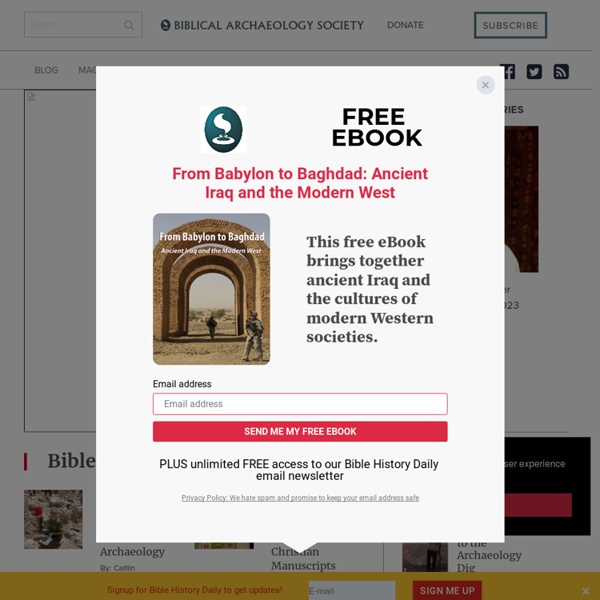



Bible Study Magazine Histoire et archéologie : Qu'est-ce que l'archéologie ? Le tourisme, les voyages et l'archéologie The Emergence of Civilizations - Anthro 341 Schedule of readings, assignments, and due dates: All the assigned readings are listed here, along with due dates, test dates, and so on. Each date shows the readings in the textbook and the online items you should read before the class session on that date. The list also has links to my lecture notes, and the Powerpoint slides you see in class. The lecture notes will usually be posted before the class session, while the slides will usually be posted after it. Some people print the the lecture notes and bring them to class to add their own comments, rather than trying to write everything down. Read the assignments before the class session. Tuesday, Aug. 26: Introduction to the course Notes (36 Kb)No Slides for this class Video in class: The Hunters No reading Thursday, Aug. 28: Society without civilization: The foraging way of life Tuesday, Sept. 2: What do we mean by "civilization"? Click on the Handout that you want. Interesting, illustrated, easy, optional... check these out.
WORLD Magazine | Salty dogma | Gene Edward Veith | Aug 06, 05 Is Bono, the lead singer and songwriter for the rock group U2, a Christian? He says he is and writes about Christianity in his lyrics. Yet many people question whether Bono is "really" a Christian, due to his notoriously bad language, liberal politics, and rock star antics (though he has been faithfully married for 23 years). But in a new book of interviews, Bono in Conversation by Michka Assayas, Bono, though using some salty language, makes an explicit confession of faith. The interviewer, Mr. The interviewer asks, What's that? We see you’ve been enjoying the content on our exclusive member website. The interviewer asks, Like what? Then the interviewer marvels, "The Son of God who takes away the sins of the world. "The point of the death of Christ is that Christ took on the sins of the world, so that what we put out did not come back to us, and that our sinful nature does not reap the obvious death," replies Bono.
The Archaeology of Mesopotamia: Ceremonial centers, urbanization and state formation in Southern Mesopotamia Useful Links Uruk and Late Uruk Period entries in Cuneiform Digital Library Initiative wiki (at UCLA) Lecture notes Introduction: The spectacular development scheme of the Eridu temple is actually is a very valuable set of evidence, not only telling us about archietctural achievements of the Ubaid period in the southern Mesopotamia, but also we will see that it will form some sort of a bridge that connects the architectural and cultic traditions of the Ubaid period, that is the 4th millennium to the 3rd millennium, the following period, called Uruk period, after the massive type site of famous Uruk, in southern Mesopotamian plain, a little bit upstream than Eridu, but still on the ancient course of the Euphrates. Rituals, temples and ceremonial space of the early Mesopotamian city Rituals are usually understood as a performance that involves gestures, words, and objects, and they are usually performative, and they become social spectacles, and they are often repeated. Pottery: Excavations.
Christian Music, Christ, Community | CCMMagazine.com Main Page The Internet Ancient History Sourcebook has expanded greatly since its creation, and now contains hundred of local files as well as links to source texts throughout the net. See Introduction for an explanation of the Sourcebook's goals. See the Help! page for all the help on research I can offer. Although I am more than happy to receive notes if you have comments on this web site, I cannot answer specific research enquiries [and - for students - I cannot, or rather will not, do your homework.] The Ancient History Sourcebook works as follows: This Main Index page [this page] shows all sections and sub sections. To access the sub-section pages , simply browse the sections below and select the highlighted (white text with blue background) section title on the left. In addition there are two navigation bars on the left of each page for every sub-section For materials added since July 1998 see the New Additions page. Additional Study/Research Aids Introduction Paul Halsall , Compiler and Editor
Christian Business Daily Zoroastrianism Iranian religion founded by Zoroaster With possible roots dating back to the 2nd millennium BCE, Zoroastrianism enters recorded history around the middle of the 6th century BCE.[10] It served as the state religion of the ancient Iranian empires for more than a millennium (approximately from 600 BCE to 650 CE), but declined from the 7th century CE onwards as a direct result of the Arab-Muslim conquest of Persia (633–654 CE), which led to the large-scale persecution of the Zoroastrian people. Recent estimates place the current number of Zoroastrians in the world at around 110,000–120,000[12] at most, with the majority of this figure living in India, Iran, and North America; their number has been thought to be declining.[13][14] Terminology The name Zoroaster (Ζωροάστηρ) is a Greek rendering of the Avestan name Zarathustra. Overview Theology Practices Ossuary with reliefs of Zoroastrian priests attending a fire, Mullakurgan (near Samarkand), Uzbekistan, 7-8th century CE.[52] History Conversion
Home - Winsomewit.com